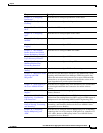
-l
Cisco ASR 901 Series Aggregation Services Router Software Configuration Guide
OL-23826-09
Chapter
Conventions
This publication uses the following conventions to convey instructions and information.
Note Means reader take note. Notes contain helpful suggestions or references to material not covered in the
manual.
Timesaver Means the described action saves time.
Chapter 37, “IPv6 over MPLS:
6PE and 6VPE”
Describes how to implement IPv6 VPN Provider Edge Transport over
MPLS (IPv6 on Provider Edge Routers [6PE] and IPv6 on ASR 901.
Chapter 38, “Storm Control” Describes how to monitor the incoming broadcast, multicast, and
unknown unicast packets and prevent them from flooding the LAN
ports.
Chapter 39, “Remote
Loop-Free Alternate - Fast
Reroute”
Describes the Remote Loop-free Alternate (LFA) - Fast Reroute
(FRR) feature that uses a backup route, computed using dynamic
routing protocol during a node failure, to avoid traffic loss.
Chapter 40, “Digital Optical
Monitoring”
Provides information on the digital optical monitoring (DOM) feature
for the Cisco ASR 901 Series Aggregation Services Router.
Chapter 41, “Autonomic
Networking Infrastructure”
Describes how the Autonomic Networking Infrastructure feature
makes new and unconfigured devices securely reachable by an
operator or network management system.
Chapter 41, “IPv4 Multicast” Describes how to configure IP multicast in an IPv4 network.
Chapter 42, “IPv6 Multicast” Describes how to configure basic IP multicast in an IPv6 network.
Chapter 43, “Configuring
Switched Port Analyzer”
Describes how to configure a switched port analyzer (SPAN) on the
Cisco ASR 901 Router.
Chapter Description
Convention Description
boldface font Commands and keywords.
italic font Variables for which you supply values.
[ ] Keywords or arguments that appear within square brackets are optional.
{x | y | z} A choice of required keywords appears in braces separated by vertical bars. You must
select one.
screen font
Examples of information displayed on the screen.
boldface
screen
font
Examples of information the user enters.
< > Nonprinting characters, for example passwords, appear in angle brackets.
[ ] Default responses to system prompts appear in square brackets.


















